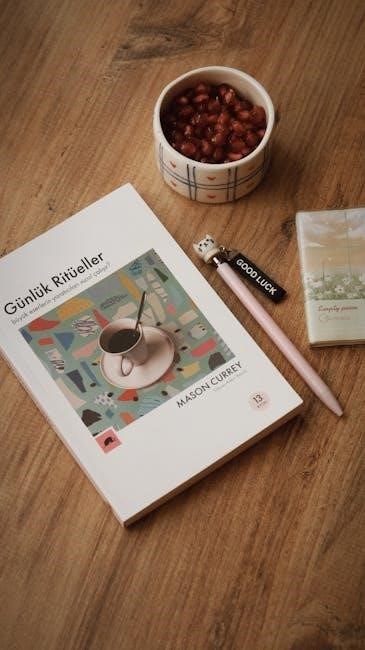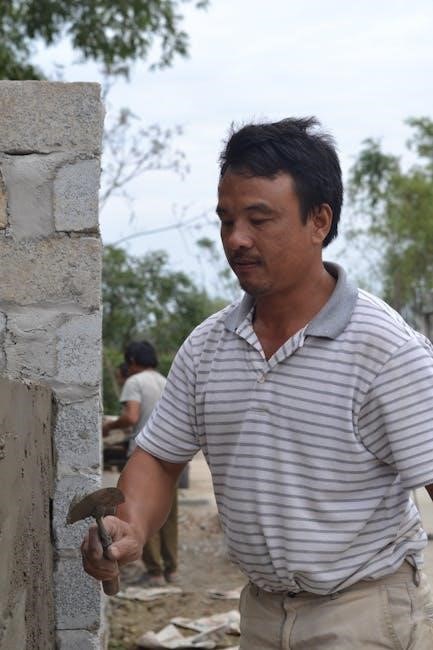Overview of “Shiloh” by Bobbie Ann Mason
Bobbie Ann Mason’s “Shiloh” poignantly portrays the marital struggles of Leroy and Norma Jean Moffitt in contemporary Kentucky․ It explores themes of loss, changing gender roles, and the search for self-discovery amidst a communication breakdown․
Character Analysis
The story delves into the evolving identities of Leroy and Norma Jean․ Leroy grapples with newfound domesticity after an injury․ Norma Jean seeks independence through bodybuilding and education, challenging traditional roles․
Leroy Moffitt’s Transformation
Leroy Moffitt, initially a truck driver, experiences a forced transformation due to a leg injury that confines him to his home․ This accident drastically alters his sense of self and purpose, compelling him to confront a life devoid of his accustomed routine and masculine identity․ He becomes increasingly involved in domestic activities, such as crafting model kits, revealing a newfound appreciation for the intricacies of creation and construction․ However, this shift also underscores his struggle to adapt to his new reality and find meaning beyond his former profession․
Leroy’s attempts to connect with Norma Jean through shared activities, like building a log cabin, highlight his desire to rebuild their relationship․ Yet, his efforts often fall short, exposing the growing distance between them․ He grapples with understanding Norma Jean’s evolving aspirations and the challenges to their traditional roles within the marriage, ultimately leading to a poignant realization of their diverging paths․
Norma Jean’s Evolving Identity
Norma Jean Moffitt undergoes a significant transformation as she seeks to redefine herself beyond the confines of her traditional role as a wife and homemaker․ She actively pursues personal growth through bodybuilding and night school, challenging conventional expectations and asserting her independence․ Her newfound interests and ambitions reflect a desire to break free from the stagnation she feels in her marriage and small-town life․ Norma Jean’s pursuit of physical strength symbolizes her emotional and intellectual empowerment, as she literally and figuratively builds herself up․
As Norma Jean embraces new opportunities, she distances herself from Leroy, highlighting the growing chasm between their aspirations․ She sheds traditional feminine roles, leaving her dirty cereal bowl on the table, signifying a subtle rebellion against domestic expectations․ Her decision to leave Leroy at Shiloh Military Park underscores her final step towards self-discovery and her resolve to forge her own path, independent of their shared past․

Themes in “Shiloh”
“Shiloh” explores marital discord, the impact of loss, and evolving gender roles․ The story delves into communication breakdown and the characters’ journeys toward self-discovery amidst changing Southern traditions․
Marital Discord and Communication Breakdown
In “Shiloh,” Bobbie Ann Mason masterfully portrays the growing rift between Leroy and Norma Jean Moffitt․ Leroy’s forced retirement due to a truck driving accident throws their established dynamic into disarray, exposing underlying tensions․ Communication becomes increasingly strained as they struggle to adapt to their new roles․ Norma Jean’s pursuit of bodybuilding and night classes highlights her desire for independence, contrasting with Leroy’s longing for traditional domesticity․ The story subtly reveals their inability to articulate their needs and frustrations, leading to a gradual emotional detachment․ The unspoken grief over the loss of their infant son further complicates their connection․ Their marriage is at a turning point․
The Impact of Loss and Grief
The unspoken presence of grief permeates Bobbie Ann Mason’s “Shiloh,” subtly influencing the characters’ actions and interactions․ The death of Leroy and Norma Jean’s infant son casts a long shadow over their marriage, contributing to their emotional distance and communication breakdown․ While never explicitly discussed, the loss manifests in their inability to connect on a deeper level and address the underlying issues in their relationship․ Norma Jean’s pursuit of new activities and self-improvement can be interpreted as a way to cope with the unresolved grief․ Leroy’s clinging to familiar routines and traditional roles may also be a response to the pain of the past․ The story suggests that their inability to process their shared loss hinders their ability to move forward․
Changing Gender Roles and Self-Discovery
In “Shiloh,” Bobbie Ann Mason explores the shifting landscape of gender roles in contemporary Southern society․ Norma Jean’s journey of self-discovery is marked by her rejection of traditional feminine expectations․ She challenges conventional roles by engaging in bodybuilding, attending night school, and seeking independence․ This contrasts with Leroy’s initial desire for Norma Jean to maintain a more traditional, domestic role․ As Leroy grapples with his physical limitations and loss of his truck-driving job, Norma Jean embraces new opportunities for personal growth․ Her evolving identity leads to a re-evaluation of their marriage and her own aspirations․ The story suggests that changing gender roles can create both conflict and opportunities for self-discovery within a relationship, highlighting the complexities of adapting to modern societal expectations․

Literary Significance and Style
Bobbie Ann Mason’s “Shiloh” holds significant literary weight as a representative work of contemporary American realism․ Her style is characterized by its precise observation of everyday life, capturing the nuances of working-class culture in Kentucky․ Mason employs a minimalist approach, using simple language and concrete details to convey complex emotions and relational dynamics․ The story’s strength lies in its authenticity, depicting characters grappling with universal issues of identity, loss, and marital discord․ Mason’s focus on the ordinary and her avoidance of sentimentality contribute to the story’s impact․ “Shiloh” resonates with readers due to its honest portrayal of human relationships and its exploration of the challenges faced by individuals navigating a changing social landscape․ Mason’s skillful use of language and her keen insights into human nature solidify the story’s place in contemporary literature․

Symbolism and Motifs
“Shiloh” employs symbolism, notably the Shiloh Military Park, representing turning points and battles, mirroring the couple’s marital struggles․ The story also subtly hints at the Grail motif, reflecting a quest for healing and fulfillment․
The Significance of Shiloh Military Park
The Shiloh Military Park serves as a potent symbol within Bobbie Ann Mason’s short story, acting as more than just a geographical location․ It represents a critical turning point, mirroring the pivotal moments experienced by Leroy and Norma Jean in their relationship․ Like the historical battle fought there, their marriage faces its own conflicts, wounds, and potential for change․
The park’s history, marked by immense loss and struggle during the Civil War, resonates with the couple’s unspoken grief over the loss of their child․ The visit to Shiloh becomes a journey into the heart of their unresolved issues, forcing them to confront the emotional battlefield within their marriage․ The park’s somber atmosphere underscores the weight of their past and the uncertainty of their future․ Ultimately, the significance of Shiloh Military Park lies in its ability to externalize the internal conflicts plaguing Leroy and Norma Jean, highlighting the potential for both destruction and renewal in their lives․
The Grail Motif and Its Interpretation
Critics have approached Bobbie Ann Mason’s “Shiloh” through the lens of myth-ritual criticism, particularly focusing on the Grail motif․ This perspective suggests that the story contains elements reminiscent of the Arthurian legend, where the quest for the Grail represents a search for healing and redemption․ In “Shiloh,” Leroy’s physical injury, rendering him unable to work as a truck driver, can be interpreted as the “king’s wound,” a central element of the Grail myth․
His subsequent journey, both literal and metaphorical, can be seen as a quest for wholeness․ Norma Jean’s pursuit of self-improvement, through bodybuilding and education, might also be viewed as a parallel search for something missing in her life․ However, the interpretation of the Grail motif in “Shiloh” is complex and open to debate, with some critics finding it more subtle than overt․ Whether intentional or not, the presence of these symbolic elements adds depth and layers of meaning to the story’s exploration of marital discord and personal transformation․

Critical Reception and Analysis
“Shiloh,” by Bobbie Ann Mason, has garnered significant critical acclaim for its realistic portrayal of working-class life in contemporary America and its subtle exploration of complex emotions within a marriage facing crisis․ Reviewers often praise Mason’s keen eye for detail and her ability to capture the nuances of everyday conversations, making her characters relatable and authentic․
The story’s themes of marital discord, changing gender roles, and the search for self-discovery have resonated with readers and critics alike, leading to numerous analyses of its underlying meanings․ Some critics focus on the symbolism of the Shiloh Military Park, while others explore the potential influence of the Grail motif on the narrative․ Mason’s writing style, often compared to that of Raymond Carver and Ann Beattie, has also been lauded for its simplicity and directness, which effectively conveys the emotional weight of the story․



